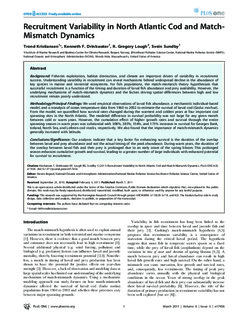| dc.description.abstract | Background
Fisheries exploitation, habitat destruction, and climate are important drivers of variability in recruitment success. Understanding variability in recruitment can reveal mechanisms behind widespread decline in the abundance of key species in marine and terrestrial ecosystems. For fish populations, the match-mismatch theory hypothesizes that successful recruitment is a function of the timing and duration of larval fish abundance and prey availability. However, the underlying mechanisms of match-mismatch dynamics and the factors driving spatial differences between high and low recruitment remain poorly understood.
Methodology/Principal Findings
We used empirical observations of larval fish abundance, a mechanistic individual-based model, and a reanalysis of ocean temperature data from 1960 to 2002 to estimate the survival of larval cod (Gadus morhua). From the model, we quantified how survival rates changed during the warmest and coldest years at four important cod spawning sites in the North Atlantic. The modeled difference in survival probability was not large for any given month between cold or warm years. However, the cumulative effect of higher growth rates and survival through the entire spawning season in warm years was substantial with 308%, 385%, 154%, and 175% increases in survival for Georges Bank, Iceland, North Sea, and Lofoten cod stocks, respectively. We also found that the importance of match-mismatch dynamics generally increased with latitude.
Conclusions/Significance
Our analyses indicate that a key factor for enhancing survival is the duration of the overlap between larval and prey abundance and not the actual timing of the peak abundance. During warm years, the duration of the overlap between larval fish and their prey is prolonged due to an early onset of the spring bloom. This prolonged season enhances cumulative growth and survival, leading to a greater number of large individuals with enhanced potential for survival to recruitment. | no_NO |
